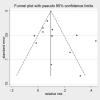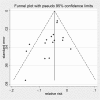Using digital notifications to improve attendance in clinic: systematic review and meta-analysis
- PMID: 27798006
- PMCID: PMC5093388
- DOI: 10.1136/bmjopen-2016-012116
Using digital notifications to improve attendance in clinic: systematic review and meta-analysis
Abstract
Objectives: Assess the impact of text-based electronic notifications on improving clinic attendance, in relation to study quality (according to risk of bias), and to assess simple ways in which notifications can be optimised (ie, impact of multiple notifications).
Design: Systematic review, study quality appraisal assessing risk of bias, data synthesised in meta-analyses.
Data sources: MEDLINE, EMBASE, PsycINFO, Web of Science and Cochrane Database of Systematic Reviews (01.01.05 until 25.4.15). A systematic search to discover all studies containing quantitative data for synthesis into meta-analyses.
Eligibility criteria: Studies examining the effect of text-based electronic notifications on prescheduled appointment attendance in healthcare settings. Primary analysis included experimental studies where randomisation was used to define allocation to intervention and where a control group consisting of 'no reminders' was used. Secondary meta-analysis included studies comparing text reminders with voice reminders. Studies lacking sufficient information for inclusion (after attempting to contact study authors) were excluded.
Outcome measures: Primary outcomes were rate of attendance/non-attendance at healthcare appointments. Secondary outcome was rate of rescheduled and cancelled appointments.
Results: 26 articles were included. 21 included in the primary meta-analysis (8345 patients receiving electronic text notifications, 7731 patients receiving no notifications). Studies were included from Europe (9), Asia (7), Africa (2), Australia (2) and America (1). Patients who received notifications were 23% more likely to attend clinic than those who received no notification (risk ratio=1.23, 67% vs 54%). Those receiving notifications were 25% less likely to 'no show' for appointments (risk ratio=.75, 15% vs 21%). Results were similar when accounting for risk of bias, region and publication year. Multiple notifications were significantly more effective at improving attendance than single notifications. Voice notifications appeared more effective than text notifications at improving attendance.
Conclusions: Electronic text notifications improve attendance and reduce no shows across healthcare settings. Sending multiple notifications could improve attendance further.
Keywords: Reminders; clinic attendance; healthcare efficiency; no shows.
Published by the BMJ Publishing Group Limited. For permission to use (where not already granted under a licence) please go to http://www.bmj.com/company/products-services/rights-and-licensing/.
Conflict of interest statement
All authors have completed the International Committee of Medical Journal Editors (ICMJE) uniform disclosure form at www.icmje.org/coi_disclosure.pdf and declare: no support from any organisation for the submitted work; no financial relationships with any organisations that might have an interest in the submitted work in the previous 3 years; no other relationships or activities that could appear to have influenced the submitted work.
Figures





References
-
- Torjesen I. Patients will be told cost of missed appointments and May be charged. BMJ 2015;351:h3663. - PubMed
-
- Zailinawati A, Ng C, Nik-Sherina H. Why do patients with chronic illnesses fail to keep their appointments? A telephone interview. Asia Pac J Public Health 2005;18:10–15. - PubMed
-
- Killaspy H, Banerjee S, King M et al. . Prospective controlled study of psychiatric out-patient non-attendance—characteristics and outcome. Br J Psychiatry 2000;176:160–5. - PubMed
-
- van Dieren Q, Rijckmans MJN, Mathijssen JJP et al. . Reducing no-show behavior at a community mental health center. J Community Psychol 2013;41:844–50.
Publication types
MeSH terms
LinkOut - more resources
Full Text Sources
Other Literature Sources
